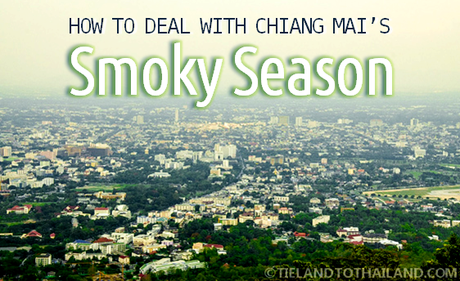 The time of year infamously known as Chiang Mai's smoky season has arrived. Perhaps one of travelers' biggest worries is planning a trip to northern Thailand and not knowing how bad the air quality is. After living through two of Chiang Mai's smoky seasons and about to go through a third, here's what you can generally expect during the worst of it and how to handle it.
The time of year infamously known as Chiang Mai's smoky season has arrived. Perhaps one of travelers' biggest worries is planning a trip to northern Thailand and not knowing how bad the air quality is. After living through two of Chiang Mai's smoky seasons and about to go through a third, here's what you can generally expect during the worst of it and how to handle it.
Chiang Mai's hot smoky season doesn't get into full swing until March, but for the past two years, we've noticed the beginnings of haziness as early as January. February and the beginning of April can be quite smoggy, too.
What Causes Chiang Mai's Smoky Season?
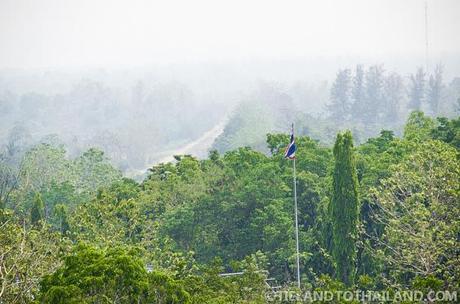
The smoky season is caused by several different factors, although we can't say for certain which is the biggest contributor.
It's well-known that local farmers burn fields and brush to get ready for a new season of crops. We've driven past farmland just outside Chiang Mai's Old City and smoke trails can be easily seen from the road. We've also seen smoke wafting up from the hills and nearby mountains. Locals also burn their trash, but that is arguably a year round thing.
Additionally, it's hard to miss the dark grey smog spewing from vehicles' exhaust pipes, particularly from Chiang Mai's songthaews and tuk tuks. When the high season rolls around between October and February, the increased traffic adds to the air pollution.
Chiang Mai is also situated between Doi Suthep and Doi Saket. The nearby mountains of Doi Inthanon and Doi Khun Tan also help to create a valley that traps the dense vehicle smog and crop burning smoke over Chiang Mai.
And not to be forgotten, the last rainstorm passes through Chiang Mai near the end of October. No frequent rain to clean the air means by the time it's March, the land and air are dry and dusty.
What to Expect During Chiang Mai's Smoky Season
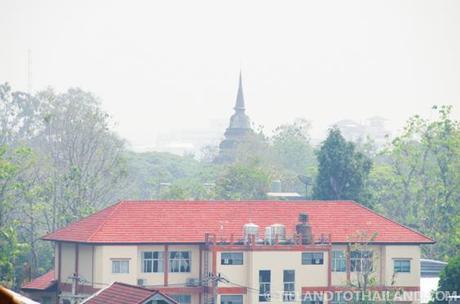
Chiang Mai's smoky season is apparent by yellow skies, lack of visibility, and a lingering campfire smell in the air.
Chang Mai's robin egg blue skies and fluffy white clouds are replaced by a dingy yellow haze. Even nearby hills and buildings can be difficult to see and often disappear entirely on bad days. On the worst days, the local mountain, Doi Suthep, cannot be seen and even the sun is blocked out.
The smell of smoke lingers in the air. We smell it in the morning when we first step outside or open our windows. When we go out for the evening or line dry our laundry, our clothes and hair smell like we've been hanging out around a bonfire.
We also noticed that many surfaces develop a thin gritty film on them, and often we can see the dust clouds hanging in the air that are created by passing cars and nearby construction.
Health Effects of Chiang Mai's Smoky Season
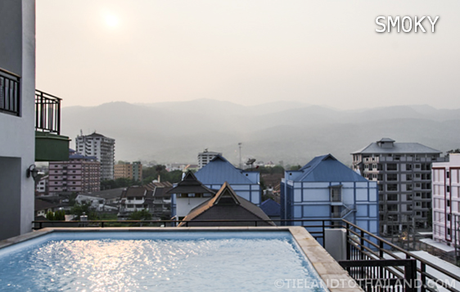
The dust, dirt, and smoke particles contribute to a poor air quality index ( AQI). Particles that are smaller than 10 microns in diameter ( PM10 or less) are considered to have adverse health effects. Carbon monoxide, nitrogen dioxide, and sulfur dioxide also contribute to AQI levels.
Chiang Mai's AQI levels can be viewed in real-time, although this site doesn't show seasonal trends or a yearly comparison. For those who are interested in conveniently monitoring the air quality, there's also an app called Air4Thai available for Android and Apple smartphones.
In general, the higher the AQI, the hazier it is and the greater toll it can take on your lungs. Some people may also experience sinus trouble. For others, the smog can cause bronchial inflammation, labored breathing, or an asthma attack.
How to Combat Chiang Mai's Smoky Season
For those concerned with the adverse health effects caused by the increased air pollution during Chiang Mai's smoky season, there are a few options to keep you healthy, both indoors and outdoors.
01 Stay Indoors During Peak Hours
Simply staying indoors during the hottest times in the afternoon will do wonders for most people. Chiang Mai's smoky season also coincides with some of the hottest temperatures of the year, so we find ourselves preferring to go out in the mornings and evenings anyways. We make sure to keep our windows shut, too, and turn on the fan if we want air circulation in our house.
02 Wear N95 Grade Masks
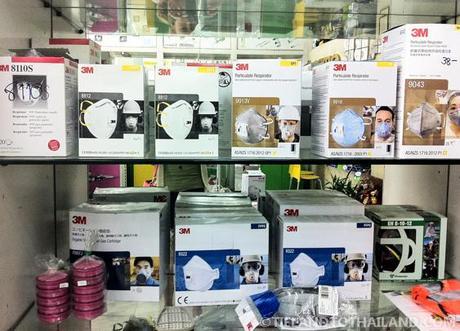
If the smog is bothersome while you're outside, wearing face masks with a proper filter grade will protect your lungs and sinuses.
These are not the surgical looking masks that can be purchased at 7-Elevens and mini Tescos's for super cheap. We've seen local Thai's wearing these thin white masks during the burning season, but they don't protect the lungs from the finer particles.
Instead, look for a mask that specifically advertises a filter grading of at least N95. These masks should also fit snugly around the nose and mouth and there should be no open gaps on the sides to allow unfiltered air in.
Masks like these can be purchased at large department stores, such as HomePro, or hardware stores featuring 3M products. Masks generally cost around 150 baht ($5 USD) each.
03 Invest in an Indoor Air Purifier
Air conditioning units can filter the air for larger particles, such as lint and hair. However, investing in a stand-up air filter for your home or apartment can keep your lungs and sinuses happy indoors because it traps the smaller particles.
There are many brands on the market and are generally accessible at the major home appliance stores and super centers, such as HomePro. These air purifiers are expensive, but it's worth the investment for people who are more sensitive to the air quality.
Although we don't have an indoor air filter, we use a neti pot to clean out our sinuses from time to time. We bought ours from a small pharmacy at Chiang Mai Gate and use it when the dust and smoke makes our noses itch. There are different brands and styles of neti pots, but we prefer the squeezable ones to the ones that work off gravity alone.
04 Enjoy Time in Southern Thailand
Otherwise, you can do what we've planned to do and vacation in the southern beach regions of Thailand. The crop burnings are so few and far between that they affect the air quality much less. We've recommended this to others in the past.
Our Experience with Chiang Mai's Smoky Season
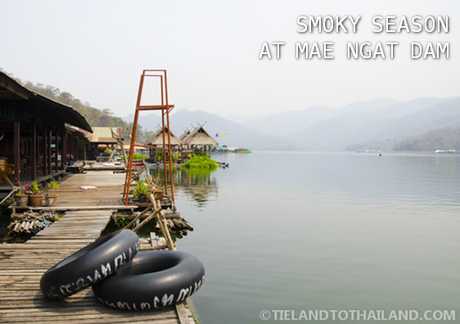
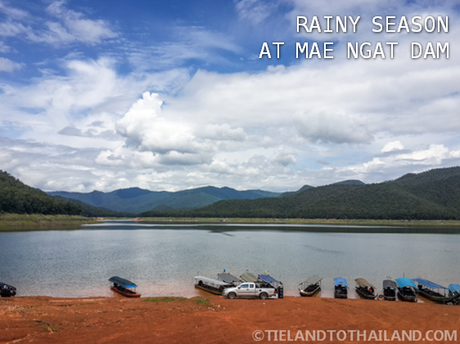
We first arrived in Chiang Mai in March 2013 right as the burning season was kicking into high gear. We noticed the haziness and lingering smell of a campfire, but weren't overly affected by the dry heat or the smoke at the time. We attributed this to being preoccupied with getting settled into our new apartment and being so excited about finally moving to Thailand.
It wasn't until the rain showed up sporadically in April and May that we noticed an improvement in the visibility and the air quality.
Chiang Mai's smoky season last year (2014) seemed to be much worse. We did invest in face masks with the proper N95 filter grade. Chris noticed that his sinuses flared up when he didn't use his mask outside when we were on our motorbike. We also adjusted our schedule and stayed inside between 2pm and 6pm when we thought it was the hottest. We also generally avoided outdoor restaurants and cafés.
The Bottom Line
Chiang Mai's smoky season can make you physically uncomfortable, and you definitely miss out on the picturesque views. It's no wonder why tourists are hesitant to visit Chiang Mai during the burning season and why locals tend to vacation down south during this time.
We wouldn't personally recommend visiting northern Thailand in February, March, or April if you have breathing problems triggered by air pollution. However, we think most people will enjoy their time here as long as they know the limitations of their own body and use caution when outside. After all, we're sure almost anyone would be thrilled to spend time in Chiang Mai, smoky season or not!
We now offer professional travel prep via our Thailand Coaching Sessions and trip planning through our custom Travel Itineraries .

